Controlling PDF content and quality
For more control over the content and quality of the resulting PDF, use File > Export as PDF. The PDF Options dialog box opens. This dialog box has five pages (General, Initial View, User Interface, Links, and Security). Make your selections, and then click Export. Then you are asked to enter the location and file name of the PDF to be created, and click Save to export the file.
General page of PDF Options dialog box
On the General page, you can choose which document pages to include in the PDF, the type of compression to use for images (which affects the quality of images in the PDF), and other options.
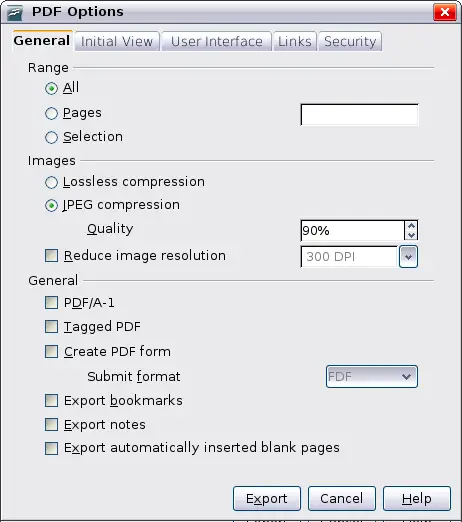
General page of PDF Options dialog box.
Range section
- All: Exports the entire document.
- Pages: To export a range of pages, use the format 3-6 (pages 3 to 6). To export single pages, use the format 7;9;11 (pages 7, 9, and 11). You can also export a combination of page ranges and single pages, by using a format like 3-6;8;10;12.
- Selection: Exports whatever material is selected.
Images section
- Lossless compression: Images are stored without any loss of quality. Tends to make large files when used with photographs. Recommended for other images.
- JPEG compression: Allows for varying degrees of quality. A setting of 90% tends to work well with photographs (small file size, little perceptible loss).
- Reduce image resolution: Lower-DPI (dots per inch) images have lower quality. For viewing on a computer screen generally a resolution of 72dpi (for Windows) or 96dpi (GNU/Linux) is sufficient, while for printing it is generally preferable to use the highest dpi value. Note that the dpi setting affects the size of the exported file considerably.
 | EPS images with embedded previews are exported only as previews. EPS images without embedded previews are exported as empty placeholders.
|
General section
- PDF/A-1: PDF/A is an ISO standard established in 2005 for long-term preservation of documents, by embedding all the pieces necessary for faithful reproduction (such as fonts) while forbidding other elements (including forms, security, encryption, and tagged PDF). If you select PDF/A-1, the forbiden elements are greyed-out (not available). Because the fonts are embedded in the PDF file, the document will appear as the author intended even if the machine where it is viewed does not support the chosen font types.
- Tagged PDF: Exports special tags into the corresponding PDF tags. Some tags that are exported are table of contents, hyperlinks, and controls. This option can increase file sizes significantly.
- Create PDF form - Submit format: Choose the format of submitting forms from within the PDF file. This setting overrides the control’s URL property that you set in the document. There is only one common setting valid for the whole PDF document: PDF (sends the whole document), FDF (sends the control contents), HTML, and XML. Most often you will choose the PDF format.
- Export bookmarks: Creates PDF bookmarks for all outline paragraphs and for all table of contents entries for which you assigned hyperlinks.
- Export notes: Exports notes in Writer and Calc documents as PDF notes. You may not want this!
- Export automatically inserted blank pages: If selected, automatically inserted blank pages are exported to the PDF. This is best if you are printing the PDF double-sided. For example, books usually have chapters set to always start on an odd-numbered (right-hand) page. When the previous chapter ends on an odd page, OOo inserts a blank page between the two odd pages. This option controls whether to export that blank page.
Initial View page of PDF Options dialog box
On the Initial View page, you can choose how the PDF opens by default in a PDF viewer. The selections should be self-explanatory.
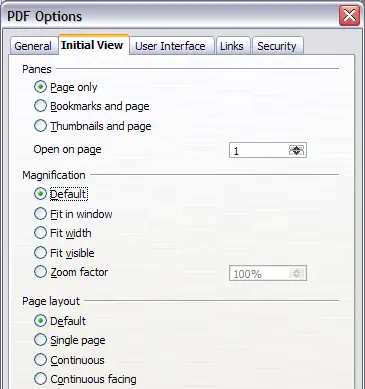
Initial View page of PDF Options dialog box.
User Interface page of PDF Options dialog box
On the User Interface page, you can choose more settings to control how a PDF viewer displays the file. Some of these choices are particularly useful when you are creating a PDF to be used as a presentation or a kiosk-type display.
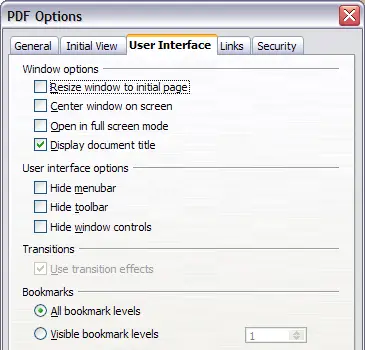
User Interface page of PDF Options dialog box.
Window options section
- Resize window to initial page. Causes the PDF viewer window to resize to fit the first page of the PDF.
- Center window on screen. Causes the PDF viewer window to be centered on the computer screen.
- Open in full screen mode. Causes the PDF viewer to open full-screen instead of in a smaller window.
- Display document title. Causes the PDF viewer to display the document’s title in the title bar.
User interface options section
- Hide menubar. Causes the PDF viewer to hide the menu bar.
- Hide toolbar. Causes the PDF viewer to hide the toolbar.
- Hide window controls. Causes the PDF viewer to hide other window controls.
Bookmarks
Select how many heading levels are displayed as bookmarks, if Export bookmarks is selected on the General page.
Links page of PDF Options dialog box
On this page you can choose how links in documents are exported to PDF.
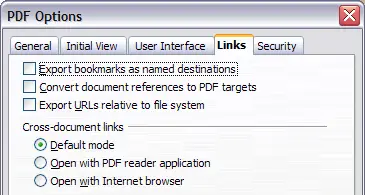
Links page of PDF Options dialog box.
Export bookmarks as named destinations
If you have defined Writer bookmarks, this option exports them as “named destinations” to which Web pages and PDF documents can link.
Convert document references to PDF targets
If you have defined links to other documents with OpenDocument extensions (such as .ODT, .ODS, and .ODP), this option converts the files names to .PDF in the exported PDF document.
Export URLs relative to file system
If you have defined relative links in a document, this option exports those links to the PDF.
Cross-document links
Defines the behavior of the PDF links to other files. Select one among the following alternatives:
- Default mode: The PDF links will be handled as specified in your operating system.
- Open with PDF reader application: Use the same application used to display the PDF document to open linked PDF documents.
- Open with Internet browser: Use the default Internet browser to display linked PDF documents.
Security page of PDF Options dialog box
PDF export includes options to encrypt the PDF (so it cannot be opened without a password) and apply some digital rights management (DRM) features.
- With an open password set, the PDF can only be opened with the password. Once opened, there are no restrictions on what the user can do with the document (for example, print, copy, or change it).
- With a permissions password set, the PDF can be opened by anyone, but its permissions can be restricted.
- With both the open password and permission password set, the PDF can only be opened with the correct password, and its permissions can be restricted.
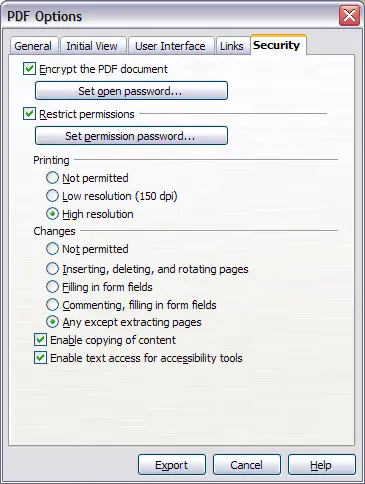
Security page of PDF Options dialog box.
 | Permissions settings are effective only if the user’s PDF viewer respects the settings.
|
The figure below shows the pop-up dialog box displayed when you click the Set open password button on the Security page of the PDF Options dialog box.
After you set a password for permissions, the other choices on the Security page become available. These selections should be self-explanatory.
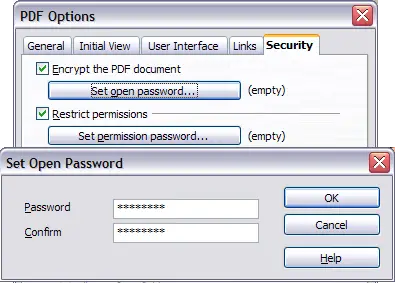
Setting a password to encrypt a PDF.
